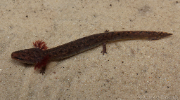Apalachicola Waterdog (Necturus moleri)
Description: Necturus moleri is a neotenic species of aquatic salamander with adults reaching a standard length of up to 173 mm. Adult males average 126.4 mm and females average 102.3 mm in snout-vent length. Males reach sizes that average 24 mm longer in standard length than females. Tail length in male reaches a maximum of 73 mm and in female reaches up to 63 mm. This species is identified as a member of the family Proteidae by retention of external gills in adults, and the presence of four robust limbs with four toes on the hind limbs. Typically, sixteen costal grooves are present (range of 16 to 17). Reproductive males can be distinguished from adult females by the presence of a swollen cloaca, a cloacal lining of finger-like projections, and a spur-like tip on each side of the posterior end of the cloacal opening.
Adults and larvae of Apalachicola Waterdogs are most difficult to distinguish from those of Escambia Waterdogs (N. mounti). However, adults of Escambia Waterdogs typically have a wide, spotless belly while adults of Apalachicola Waterdogs have dark spotting that invades the ventrolateral area
Habitat: Apalachicola Waterdogs occur in slow-moving streams where they are most frequently detected in accumulated piles of submerged leaf litter
Range: It is found in southeastern Alabama, the Panhandle of Florida, and southwestern to north-central Georgia. It is found in the Apalachicola, Chipola, Choctawhatchee/Pea, Econfina, and Ochlockonee river basins.
Found in these States:
AL |
FL |
GA |
Diet: Larvae and adults likely eat isopods, midges, mayflies, and caddisflies.
Reproduction: Adult Apalachicola Waterdogs are most likely to be detected in winter months (November to January), when mating occurs. Fertilization occurs via transfer of a spermatophore deposited by a male to a female who picks it up with her cloacal lips. Fertilized eggs are retained within a female's uterus until the clutch is deposited, likely in April or May. Nests are thought to be placed in leaf packs. After hatching, larvae can be sampled from leaf packs, eventually reaching adult size in 4 to 6 years
Status: listed as Critically Imperiled in Alabmaa, Imperiled in Florida and Vulnerable in Georgia.
Taxonomy: Committed on 10-28-2020: Necturus beyeri split into Necturus beyeri, Necturus mounti, & Necturus moleri
»» Kingdom: Animalia - Animals
»» Phylum: Chordata - Chordates
»» Subphylum: Vertebrata - Vertebrates
»» Class: Amphibia - (Amphibians)
»» Order: Caudata - Salamanders
»» Family: Proteidae - Mudpuppies & Olm
»» Genus: Necturus
»» Species: Necturus moleri - Apalachicola Waterdog
This article uses material from the Wikipedia article "Apalachicola Waterdog", which is released under the Creative Commons Attribution-Share-Alike License 3.0. Content may have been omitted from the original, but no content has been changed or extended.
|











